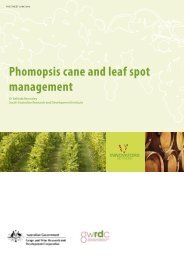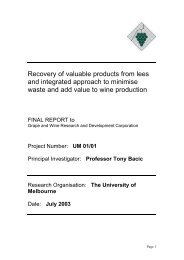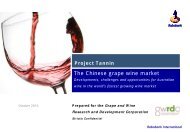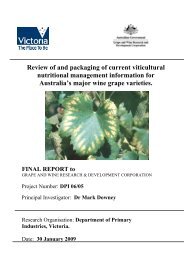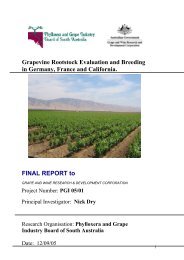Identification of the major drivers of 'phenolic' taste in ... - GWRDC
Identification of the major drivers of 'phenolic' taste in ... - GWRDC
Identification of the major drivers of 'phenolic' taste in ... - GWRDC
Create successful ePaper yourself
Turn your PDF publications into a flip-book with our unique Google optimized e-Paper software.
AWRI: <strong>Identification</strong> Of The Major Drivers Of ‘Phenolic’ Taste In White W<strong>in</strong>es<br />
83<br />
Astr<strong>in</strong>gency<br />
Viscosity<br />
3.5<br />
3.0<br />
2.5<br />
2.0<br />
1.5<br />
r= -0.87<br />
1.0<br />
2.9 3.0 3.1 3.2 3.3 3.4<br />
pH<br />
Figure 8-16: Perceived astr<strong>in</strong>gency vs. pH – all 2010 w<strong>in</strong>es<br />
4.0<br />
3.5<br />
3.0<br />
2.5<br />
2.0<br />
2.9 3.0 3.1 3.2 3.3 3.4<br />
pH<br />
r= 0.70<br />
Figure 8-17: Perceived viscosity vs. pH – all 2010 w<strong>in</strong>es<br />
It would be expected that under <strong>the</strong> salivary prote<strong>in</strong>-phenolic model <strong>of</strong> astr<strong>in</strong>gency, that <strong>the</strong> higher<br />
phenolic w<strong>in</strong>es should be more astr<strong>in</strong>gent ra<strong>the</strong>r than less, which was observed here. Acids are known to<br />
elicit astr<strong>in</strong>gency <strong>in</strong> <strong>the</strong>ir own right, with astr<strong>in</strong>gency be<strong>in</strong>g most strongly correlated with pH (Lawless et<br />
al. 1996). Therefore, it would appear that <strong>the</strong> variations <strong>in</strong> astr<strong>in</strong>gency <strong>in</strong> <strong>the</strong> Riesl<strong>in</strong>g and Viognier w<strong>in</strong>es




